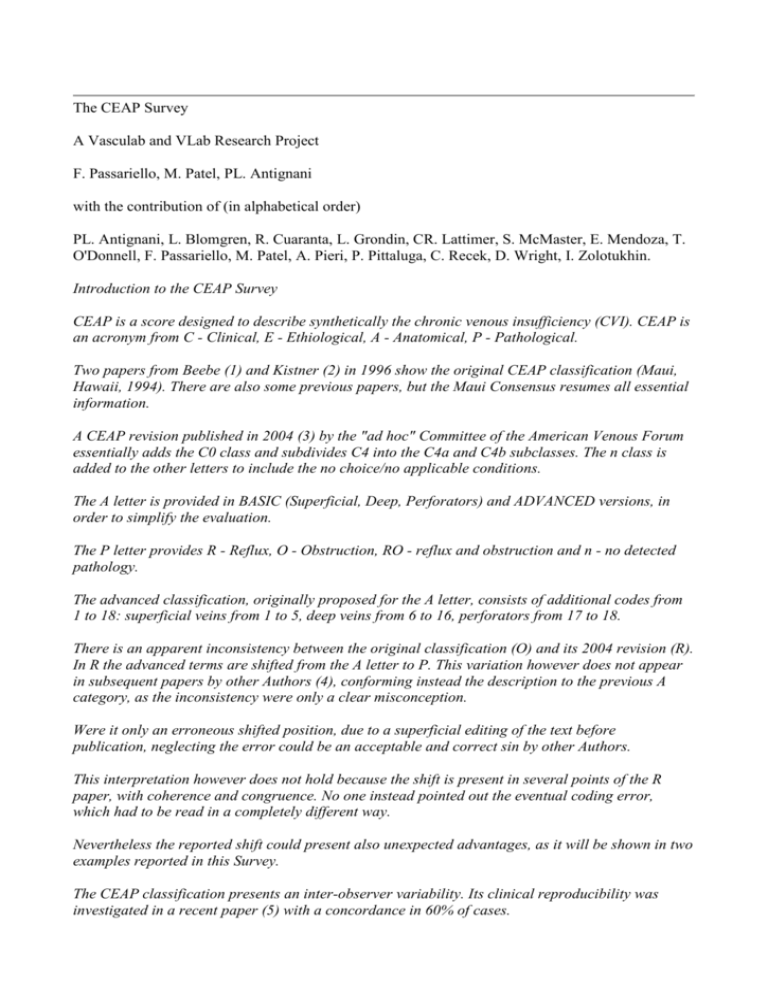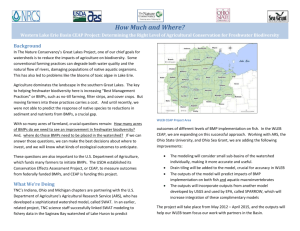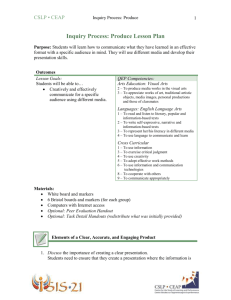The CEAP Survey A Vasculab and VLab Research Project F
advertisement

The CEAP Survey A Vasculab and VLab Research Project F. Passariello, M. Patel, PL. Antignani with the contribution of (in alphabetical order) PL. Antignani, L. Blomgren, R. Cuaranta, L. Grondin, CR. Lattimer, S. McMaster, E. Mendoza, T. O'Donnell, F. Passariello, M. Patel, A. Pieri, P. Pittaluga, C. Recek, D. Wright, I. Zolotukhin. Introduction to the CEAP Survey CEAP is a score designed to describe synthetically the chronic venous insufficiency (CVI). CEAP is an acronym from C - Clinical, E - Ethiological, A - Anatomical, P - Pathological. Two papers from Beebe (1) and Kistner (2) in 1996 show the original CEAP classification (Maui, Hawaii, 1994). There are also some previous papers, but the Maui Consensus resumes all essential information. A CEAP revision published in 2004 (3) by the "ad hoc" Committee of the American Venous Forum essentially adds the C0 class and subdivides C4 into the C4a and C4b subclasses. The n class is added to the other letters to include the no choice/no applicable conditions. The A letter is provided in BASIC (Superficial, Deep, Perforators) and ADVANCED versions, in order to simplify the evaluation. The P letter provides R - Reflux, O - Obstruction, RO - reflux and obstruction and n - no detected pathology. The advanced classification, originally proposed for the A letter, consists of additional codes from 1 to 18: superficial veins from 1 to 5, deep veins from 6 to 16, perforators from 17 to 18. There is an apparent inconsistency between the original classification (O) and its 2004 revision (R). In R the advanced terms are shifted from the A letter to P. This variation however does not appear in subsequent papers by other Authors (4), conforming instead the description to the previous A category, as the inconsistency were only a clear misconception. Were it only an erroneous shifted position, due to a superficial editing of the text before publication, neglecting the error could be an acceptable and correct sin by other Authors. This interpretation however does not hold because the shift is present in several points of the R paper, with coherence and congruence. No one instead pointed out the eventual coding error, which had to be read in a completely different way. Nevertheless the reported shift could present also unexpected advantages, as it will be shown in two examples reported in this Survey. The CEAP classification presents an inter-observer variability. Its clinical reproducibility was investigated in a recent paper (5) with a concordance in 60% of cases. CEAP is not a clinical dossier but only the description or the instantaneous image of a patient at a given moment. The score is useful to communicate this image to operators at distance in space and time. CEAP cannot be used to follow the evolution of CVI, which instead can be achieved using other tools as the Venous Clinical Severity Score (VCSS) and the Recurrent Varicose Veins after Surgery score (REVAS). This work started from a discussion on the list Vasculab, showing that satisfaction of phlebological operators about CEAP is variable, many of them pointing at several obscure and improvable points. At 20 years from the original publication and 10 years from its revision a new revision seems to be necessary. This survey was decided on Vasculab to serve as a preliminary step to gather essential information useful for a future revision. This work will not be constrained inside the Vasculab Community, being instead extended to other interested groups. References 1. Beebe HG, Bergan JJ, Bergqvist D, Eklof B, Eriksson I, Goldman MP, Greenfield LJ, Hobson II RW, Juhan C, Kistner RL, Labropoulos N, Malouf GM, Menzoian JO, Moneta GL, Myers KA, Neglen P, Nicolaides AN, O'Donnell TF, Partsch H, et al. Classification and Grading of Chronic Venous Disease in the Lower Limbs. A Consensus Statement. Eur J Vasc Endovasc Surg 12, 487492 (1996). 2. Kistner RL, Eklof B, Masuda EM. Diagnosis of chronic venous disease of the lower extremities. The "CEAP" classification. Mayo Clin Proc 1996; 71:338-345. 3. Eklof B, Rutherford RB, Bergan JB, et al. Revision of the CEAP classification for chronic venous disease: a consensus statement. J Vasc Surg 2004;40:1248-52 4. Padberg FT. CEAP Classification for Chronic Venous Disease. Dis Mon 2005;51:176-182. 5. Sinabulya H, Holmberg A, Blomgren L. Interobserver variability in the assessment of the clinical severity of superficial venous insufficiency. Phlebology published online 6 December 2013, DOI: 10.1177/0268355513515474. Available at the address http://phl.sagepub.com/content/early/2013/12/06/0268355513515474 at the date of Dec 6th, 2014. 6. Gloviczki P, Comerota AJ, Dalsing MC, Eklof BG, Gillespie DL, Gloviczki ML, Lohr JM, McLafferty RB, Meissner MH, Murad MH, Padberg FT, Pappas PJ, Passman MA, Raffetto JD, Vasquez MA, Wakefield TW. (Society for Vascular Surgery. American Venous Forum). The care of patients with varicose veins and associated chronic venous diseases: clinical practice guidelines of the Society for Vascular Surgery and the American Venous Forum. J Vasc Surg. 2011 May;53(5 Suppl):2S-48S. 7. Passariello F. CHEAP: A standard file format for interchange of Hemodynamic and venous information on venous diseases. Lagos-Algarve, Portugal 2000. Available at the address http://web.tiscali.it/afunc/chivaref/passarie/cheap.htm at the date of Dec 6th, 2014. 8. Passariello F. CHEAP: un formato file standard per lo scambio di informazioni emodinamiche e CEAP sulle malattie venose. Atti del XIII Congresso del Collegio Italiano di Flebologia. Udine, Italia 2003. Available at the address http://web.tiscali.it/afunc/chivaref/passarie/mevch_ab.htm at the date of Dec 6th, 2014. 9. Passariello F. CHEAP: a haemodynamic file format. 21st World Congress of hte International Union of Angiology, Rome, may 22-26, 2004. Available at the address (to be changed) http://web.tiscali.it/afunc/chivaref/passarie/mevch_ab.htm at the date of Dec 6th, 2014. 10. Chiesa R, Marone EM, Limoni C, Volonte' M, Petrini O. Chronic venous disorders: Correlation between visible signs, symptoms, and presence of functional disease. J. Vasc. Surg. Volume 46, Number 2. August 2007 11. Maurins U, Hoffmann BH, Loesch C, Joeckel KH, Rabe E, Pannier F. Distribution and prevalence of reflux in the superficial and deep venous system in the general population - results from the Bonn Vein Study, Germany. J Vasc Surg. 2008 Sep;48(3):680-7. (*) required fields Clinical C classes must be evaluated with a clinical and instrumental examination. More clearly, the clinical class should be stated only after the completion of all the needed investigations, in order to rule out the case or instead to classify it with CEAP. Q1 Q1) C0 is not typical of a healthy person, but of a phlebological patient who is clinically negative. In other words, C0 En An Pn is not considered in CEAP, because some items must be positive in the letters E,A,P. Do you think that these features should be more clearly stated in the CEAP text ? [], [Yes], [No], [I don't know], Any comment about ? (200 chars ) Q1comment ___________________ Q2 Q2) Lymphedema is not considered in CEAP (not C3). In phlebolymphedema there is a lymphatic disorder together with venous edema. Do you think that phlebolymphedema should be considered together with venous edema in the C3 class or separated instead and identified with a L subscript (C3L) ? Otherwise could it be excluded completely from CEAP ? [], [C3], [C3L], [excluded], [I don't know], Any comment about ? (200 chars ) Q2comment ___________________ Ethiological C - Congenital, P - Primary, S - Secondary Q3 Q3) In the real life the C, P and S items can be sometimes simultaneously present. Patients with a congenital/primary pathology could have then a thrombosis, thus presenting a causal superimposition. Do you think that a multiple selection should be allowed? [], [Yes], [No], [I don't know], Any comment about ? (200 chars ) Q3comment ___________________ Anatomical and Pathological Advanced items The advanced items can be included into the A or P letter or both. The advanced classification, originally proposed for the A letter, consists of additional codes from 1 to 18: superficial veins from 1 to 5, deep veins from 6 to 16, perforators from 17 to 18. Q4 Q4) 1st example: Reflux in the GSV above the knee and thrombosis in the GSV below the knee. Original CEAP As2,3 Pr,o. 2004 Revision As Prs2,os3. The P choice separates data, while the A choice collapses them together. In this case do you prefer to include the advanced items into the A or the P letter or both ? [], [the A letter], [the P letter], [both], [I don't know], Any comment about ? (200 chars) Q4comment ___________________ Q5 Q5) 2nd example: Reflux in the GSV above the kne, reflux and partial thrombosis in the GSV below the knee. Original CEAP As2,3 Pr,o. 2004 Revision As Prs2,3,os3. The original assigns the same score of the previous example, while the revision allows differentiation between them. In addition, the revision is able to describe efficiently also a refluxing partial recanalization. In this case do you prefer to include the advanced items into the A or the P letter or both ? [], [the A letter], [the P letter], [both], [I don't know], Any comment about ? (200 chars) Q5comment ___________________ Q6 Q6 Should the advanced terms be included into the A or the P letter or both ? [], [the A letter], [the P letter], [both], [I don't know], Any comment about ? (200 chars) Q6comment ___________________ Reflux and thrombosis CEAP deals with chronic venous disease, thus acute Superficial Vein Thrombosis (SVT) and Deep Vein Thrombosis (DVT) cannot be classified with CEAP. Here we refer to chronic SVT and DVT sequelae. Q7 Q7 Should the (R, O) classification allow multiple choices, thus eliminating the need of the RO item ? [], [Yes], [No], [I don't know], Any comment about ? (200 chars) Q7comment ___________________ Q8 Q8 Should the classification allow differentiation between chronic SVT and DVT sequelae ? [], [Yes], [No], [I don't know], Any comment about ? (200 chars) Q8comment ___________________ Q9 Q9 Should the classification allow differentiation between complete and partial thrombosis ? [], [Yes], [No], [I don't know], Any comment about ? (200 chars) Q9comment ___________________ Q10 Q10 Regarding partial thrombosis, should the classification differentiate between a partial thrombosis which does not progress to occlusion and a partial recanalization after a complete occlusion ? [], [Yes], [No], [I don't know], Any comment about ? (200 chars ) Q10comment ___________________ Shunt classification Q11 The CEAP-Shunts compatibility issue Q11) The shunt classification is a theoretical framework, strictly linked to the surgical choices in conservative surgery. Do you think that the A/P letters approach of CEAP is in conflict with the shunt classification ? Can they instead be only complementary points of view ? [], [Clearly in conflict], [No conflict, only complementary views], [I don't know], Any comment about ? (200 chars ) Q11comment ___________________ Q12 Including the shunt classification in CEAP Q12) The shunt classification is regarded by a few outstanding interventionists as an essential tool for the comprehension of chronic venous diseases. (6) Do you think that CEAP should include in the next future in some extent information from the shunt classification ? [], [Yes], [No], [I don't know], Any comment about ? (200 chars ) Q12comment ___________________ Q13 The CHEAP extension Q13) Since 2000 an anatomical/hemodynamical extension of CEAP was proposed with the name of CHEAP(7-9), in order to attach detailed morphological and functional information into the CEAP. Without entering the details, do you think that the CHEAP extension could be of practical use ? Otherwise interesting but not practical as it is or finally completely useless ? [], [useful], [interesting but it must be changed], [completely useless], [I don't know], Any comment about ? (200 chars ) Q13comment ___________________ CEAP as a whole Questions regarding CEAP as a whole are proposed at the end of the survey, thus allowing congruence between general and detailed answers provided for each item. Q14 Q14 Do you use CEAP classification routinely ? [], [Yes], [No], Any comment about ? (200 chars ) Q14comment ___________________ Q15 Q15 Do you find the CEAP classification useful in your clinical practice ? [], [Yes], [No], [I don't know], Any comment about ? (200 chars ) Q15comment ___________________ Q16 Q16 In your opinion which part of the CEAP is the most common and appropriate to use? ? [], [Clinical], [Ethiological], [Anatomical], [Pathophysiological], [No part], Any comment about ? (200 chars ) Q16comment ___________________ Q17 Q17 Do you find CEAP in its complete form easy to use? [], [Yes], [No], [I don't know], Any comment about ? (200 chars ) Q17comment ___________________ Q18 Q18) In several countries (i.e. USA and Sweden) the C classification is a criterion to select the reimbursement of therapeutic procedures. Do you think that this is an acceptable use of CEAP ? [], [Yes], [No], [I don't know], Any comment about ? (200 chars ) Q18comment ___________________ Q19 Q19 Would you recommend a simplified version of the CEAP classification that uses only C and P ? [], [Yes], [No], [I don't know], Any comment about ? (200 chars ) Q19comment ___________________ Q20 Q20 Do you feel that a CEAP revision is necessary ? [], [Yes], [No], [I don't know], Any comment about ? (200 chars ) Q20comment ___________________ About You. This isn't an anonymous survey. Personal data are gathered in order 1) to weight your answers according to your expertise 2) to avoid duplicate answers 3) to contact you in the future if and when new developments will occur. Thus filling the survey is conditioned by the authorization to use your personal data. Your name ___________________ Your surname ___________________ Please could you indicate your gender ? [], [Male], [Female], [Prefer not to say], Age [], [< =30], [31-40], [41-50], [51-60], [> 60], [Prefer not to say], Select the category that best fits your profession [], [Angiology], [Cardiology], [Cosmetic surgery], [Dermatology], [General medicine], [General surgery], [Phlebology], [Radiology], [Vascular medicine], [Vascular surgery], [Other], Where in the world [], [Afghanistan], [Albania], [Algeria], [American Samoa], [Andorra], [Angola], [Anguilla], [Antigua & Barbuda], [Argentina], [Armenia], [Aruba], [Australia], [Austria], [Azerbaijan], [Bahamas], [Bahrain], [Bangladesh], [Barbados], [Belarus], [Belgium], [Belize], [Benin], [Bermuda], [Bhutan], [Bolivia], [Bonaire], [Bosnia & Herzegovina], [Botswana], [Brazil], [British Indian Ocean Ter], [Brunei], [Bulgaria], [Burkina Faso], [Burundi], [Cambodia], [Cameroon], [Canada], [Canary Islands], [Cape Verde], [Cayman Islands], [Central African Republic], [Chad], [Channel Islands], [Chile], [China], [Christmas Island], [Cocos Island], [Colombia], [Comoros], [Congo], [Cook Islands], [Costa Rica], [Cote D'Ivoire], [Croatia], [Cuba], [Curacao], [Cyprus], [Czech Republic], [Denmark], [Djibouti], [Dominica], [Dominican Republic], [East Timor], [Ecuador], [Egypt], [El Salvador], [Equatorial Guinea], [Eritrea], [Estonia], [Ethiopia], [Falkland Islands], [Faroe Islands], [Fiji], [Finland], [France], [French Guiana], [French Polynesia], [French Southern Ter], [Gabon], [Gambia], [Georgia], [Germany], [Ghana], [Gibraltar], [Great Britain], [Greece], [Greenland], [Grenada], [Guadeloupe], [Guam], [Guatemala], [Guinea], [Guyana], [Haiti], [Hawaii], [Honduras], [Hong Kong], [Hungary], [Iceland], [India], [Indonesia], [Iran], [Iraq], [Ireland], [Isle of Man], [Israel], [Italy], [Jamaica], [Japan], [Jordan], [Kazakhstan], [Kenya], [Kiribati], [Korea North], [Korea South], [Kuwait], [Kyrgyzstan], [Laos], [Latvia], [Lebanon], [Lesotho], [Liberia], [Libya], [Liechtenstein], [Lithuania], [Luxembourg], [Macau], [Macedonia], [Madagascar], [Malaysia], [Malawi], [Maldives], [Mali], [Malta], [Marshall Islands], [Martinique], [Mauritania], [Mauritius], [Mayotte], [Mexico], [Midway Islands], [Moldova], [Monaco], [Mongolia], [Montserrat], [Morocco], [Mozambique], [Myanmar], [Nambia], [Nauru], [Nepal], [Netherland Antilles], [Netherlands (Holland, Europe)], [Nevis], [New Caledonia], [New Zealand], [Nicaragua], [Niger], [Nigeria], [Niue], [Norfolk Island], [Norway], [Oman], [Pakistan], [Palau Island], [Palestine], [Panama], [Papua New Guinea], [Paraguay], [Peru], [Philippines], [Pitcairn Island], [Poland], [Portugal], [Puerto Rico], [Qatar], [Republic of Montenegro], [Republic of Serbia], [Reunion], [Romania], [Russia], [Rwanda], [St Barthelemy], [St Eustatius], [St Helena], [St Kitts-Nevis], [St Lucia], [St Maarten], [St Pierre & Miquelon], [St Vincent & Grenadines], [Saipan], [Samoa], [Samoa American], [San Marino], [Sao Tome & Principe], [Saudi Arabia], [Senegal], [Seychelles], [Sierra Leone], [Singapore], [Slovakia], [Slovenia], [Solomon Islands], [Somalia], [South Africa], [Spain], [Sri Lanka], [Sudan], [Suriname], [Swaziland], [Sweden], [Switzerland], [Syria], [Tahiti], [Taiwan], [Tajikistan], [Tanzania], [Thailand], [Togo], [Tokelau], [Tonga], [Trinidad & Tobago], [Tunisia], [Turkey], [Turkmenistan], [Turks & Caicos Is], [Tuvalu], [Uganda], [Ukraine], [United Arab Emirates], [United Kingdom], [United States of America], [Uruguay], [Uzbekistan], [Vanuatu], [Vatican City State], [Venezuela], [Vietnam], [Virgin Islands (Brit)], [Virgin Islands (USA)], [Wake Island], [Wallis & Futana Is], [Yemen], [Zaire], [Zambia], [Zimbabwe], Do you think that this survey can be useful to the user or generally for research ? Is this survey useful ? [], [Absolutely Yes], [Yes], [No], [Absolutely No], Your remarks (400 chars) In this space you can include your comments about the survey. ___________________ I give the permission to use my personal data for the practical management of my participation. (if I do not agree, my participation isn't allowed) Privacy, please choose ! [], [I agree], [I do not agree], Submit EMail A valid email. ___________________




